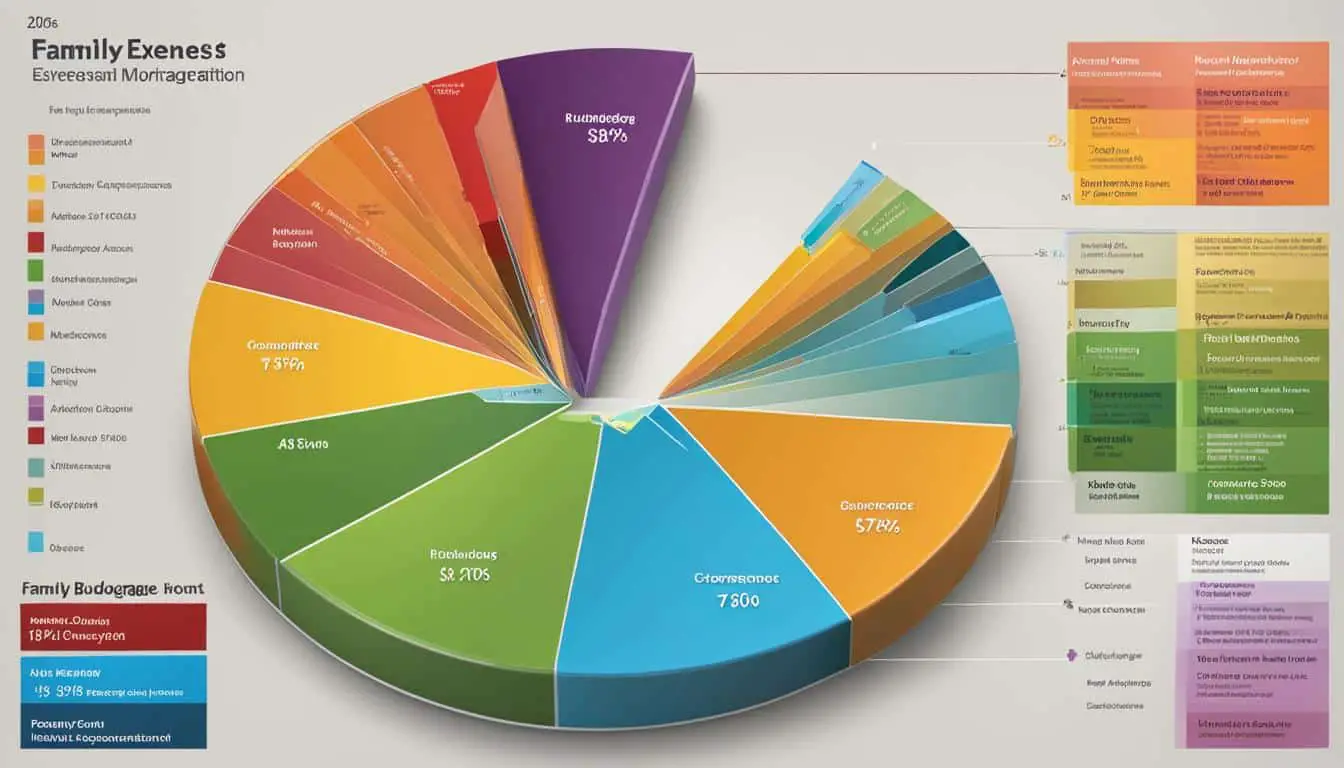Effective Family Budgeting: A Comprehensive Guide
Managing finances effectively is essential for a secure and happy family life. By implementing effective family budgeting strategies, families can not only make the most of their money but also save for the future. In this comprehensive guide, I will provide you with step-by-step instructions on successful budget planning, money-saving tips, and smart financial management techniques that will help you create a budget that aligns with your financial goals and ensures a happy family life.
Key Takeaways:
- Effective family budgeting strategies are crucial for managing finances and creating a happy family life.
- Successful budget planning involves allocating income wisely and saving for the future.
- Money-saving tips, such as tracking expenses and leveraging community resources, can significantly impact your budget.
- Smart financial management techniques, like automating savings and setting priorities, help you make informed spending decisions.
- By following this comprehensive guide, you can achieve financial stability and enjoy the benefits of frugal living.
Understanding the Budgeting Process
The budgeting process is a crucial step in effective financial management for families. By understanding and implementing proper budgeting techniques, families can gain control over their finances and build a secure future. In this section, I will explain the key aspects of the budgeting process, including calculating monthly income, distinguishing between needs and wants, prioritizing savings and debt repayment, and automating savings.
Calculate Monthly Income
The first step in budgeting is to determine your monthly income. Calculate your after-tax earnings by subtracting taxes and deductions from your gross income. It is important to have an accurate understanding of your income to plan your budget effectively.
Differentiate Between Needs and Wants
When creating a budget, it is essential to differentiate between your needs and wants. Needs are the essential expenses required for your family’s well-being, such as housing, food, utilities, and transportation. Wants, on the other hand, are discretionary expenses like dining out, entertainment, and luxury items. Allocate a certain percentage of your income for each category.
Needs before wants. Prioritizing your essential expenses ensures that your family’s basic needs are met before indulging in discretionary spending.
The 50/30/20 Rule
The 50/30/20 rule is a popular budgeting framework that can guide your allocations. According to this rule, allocate 50% of your after-tax income to cover your needs, 30% for wants, and 20% for savings and debt repayment.
| Allocation | Percentage of Income |
|---|---|
| Needs | 50% |
| Wants | 30% |
| Savings and Debt Repayment | 20% |
Adhering to this rule helps maintain a balanced budget and ensures that you allocate funds for savings and debt repayment, which are critical for long-term financial security.
Automate Savings
To make consistent progress towards your savings goals, automate your savings. Set up automatic transfers from your checking account to a separate savings account or investment vehicle. This way, you won’t have to rely on remembering to save each month, and your savings will grow effortlessly over time.
By understanding and implementing these key steps in the budgeting process, families can establish a solid foundation for effective financial management. It ensures that essential needs are met, wants are enjoyed responsibly, savings are prioritized, and debts are repaid promptly, leading to a more secure financial future for the entire family.
Try a Simple Budgeting Plan
When it comes to managing family finances, the 50/30/20 budgeting plan is a simple and effective strategy. This plan provides a clear framework for allocating your monthly after-tax income among necessities, wants, savings, and debt repayment. By following this budgeting plan, families can prioritize their financial goals, take control of their spending, and build a secure financial future.
The 50/30/20 Breakdown
The 50/30/20 budgeting plan suggests dividing your after-tax income into three categories:
- Necessities (50%): Allocate approximately 50% of your monthly income towards essential expenses like groceries, housing, utilities, and transportation. These are the expenses that you cannot do without and should take precedence in your budget.
- Wants (30%): Reserve around 30% of your income for discretionary spending on wants. This category includes dining out, entertainment, travel, and other non-essential expenses that bring enjoyment and quality of life to your family.
- Savings and Debt Repayment (20%): Dedicate the remaining 20% of your income towards savings and debt repayment. This portion of your budget is crucial for building an emergency fund, saving for future goals, and paying off any outstanding debt.
By adhering to this budgeting plan, you can ensure that you are meeting your basic needs, indulging in occasional wants, and making progress towards your long-term financial objectives.
Benefits of the 50/30/20 Budget
The 50/30/20 budgeting plan offers several benefits for families:
“The 50/30/20 budgeting plan provides a balanced approach to managing family finances. It allows families to prioritize their necessities while still enjoying discretionary spending. By allocating a significant portion of their income towards savings and debt repayment, families can secure their financial future.”
Implementing this budgeting plan can bring financial stability and peace of mind. It helps you make informed decisions about how you use your income and ensures that you are saving for the future.
Example Visualization
| Category | Percentage of After-Tax Income | Allocation Amount |
|---|---|---|
| Necessities | 50% | $1,500 |
| Wants | 30% | $900 |
| Savings and Debt Repayment | 20% | $600 |

Implementing the 50/30/20 budgeting plan can bring structure to your family’s finances and help you achieve your financial goals. By properly allocating your monthly after-tax income, you can take control of your spending, save for the future, and build a secure financial foundation.
Budgeting Tips and Strategies
To ensure the success of your family budget, it is important to implement additional tips and strategies. Here are some actionable steps that can make a difference in your financial management:
1. Tracking Expenses
Tracking expenses regularly provides a clear understanding of where your money is being spent and helps identify areas for potential savings. It is essential to keep a record of all your purchases, bills, and payments. Use budgeting apps or spreadsheets to categorize your expenses and analyze your spending habits.
2. Flexible Budgeting
Flexible budgeting is key when unexpected expenses arise. Create a buffer in your budget for unforeseen costs, such as medical emergencies or car repairs. By setting aside some money each month for these contingencies, you can maintain stability in your overall budget and avoid falling into debt.
3. Teamwork
Working as a team with your partner or spouse is crucial for open communication and shared financial goals. Sit down together regularly to review your budget, discuss upcoming expenses, and evaluate your progress towards savings goals. By having open and honest conversations about money, you can ensure everyone is on the same page and actively working towards financial success.
4. Setting Priorities
Setting priorities is essential to make informed spending decisions and stay focused on your financial goals. Take the time to identify what is truly important to your family and allocate your resources accordingly. This could mean cutting back on non-essential expenses to save for a dream vacation or investing in education for your children’s future.
5. Leveraging Community Resources
Leveraging community resources can significantly impact your overall budget. Take advantage of local groups, organizations, and online communities that offer freebies, discounts, or shared resources. For example, community gardens can provide fresh produce at a low cost, and local libraries often host free events for families. By tapping into these resources, you can save money and enrich your family’s lifestyle.
![]()
Implementing these budgeting tips and strategies can help you achieve greater financial control and stability. By tracking your expenses, being flexible, working as a team, setting priorities, and leveraging community resources, you’ll be on the path to financial success.
| Tip/Strategy | Description |
|---|---|
| Tracking Expenses | Regularly record and categorize expenses to gain insight into spending habits and identify areas for savings. |
| Flexible Budgeting | Create a buffer in your budget to account for unexpected expenses and maintain stability. |
| Teamwork | Work as a team with your partner or spouse to communicate openly about financial goals and progress. |
| Setting Priorities | Identify what is truly important to your family and allocate resources accordingly. |
| Leveraging Community Resources | Take advantage of freebies, discounts, and shared resources within your community. |
Conclusion
Effective family budgeting strategies are essential for managing finances and creating a happy family life. By following the steps outlined in this comprehensive guide, families can establish a budget that aligns with their financial goals and promotes financial stability.
One of the key elements of successful budgeting is tracking expenses. By keeping a close eye on where money is being spent, families can identify areas for potential savings and make informed spending decisions.
Implementing budgeting tips and strategies, such as setting priorities and leveraging community resources, can provide additional support in managing family finances effectively. By working together as a team and communicating openly, families can stay on track with their budget and achieve their financial goals.
Frugal living strategies and finding ways to save money on family expenses are also crucial. By being conscious of unnecessary spending and taking advantage of money-saving opportunities, families can reduce their expenses and maximize their savings.
In conclusion, by practicing effective family budgeting strategies, managing finances for families becomes a manageable task. With diligent budgeting, smart financial management, and a focus on frugal living, families can enjoy a happy and financially stable life.
FAQ
What is the first step in effective family budgeting?
The first step in effective family budgeting is to calculate your monthly income and understand your after-tax earnings.
How do I differentiate between needs and wants in my budget?
Differentiating between needs and wants involves allocating a certain percentage of your income for each category. The 50/30/20 rule is a popular budgeting framework that suggests allocating 50% for needs, 30% for wants, and 20% for savings and debt repayment.
What is the 50/30/20 budgeting plan?
The 50/30/20 budgeting plan is a simple and effective way to manage family finances. It suggests allocating approximately 50% of after-tax income for necessities, 30% for wants, and 20% for savings and debt repayment.
How can I ensure consistent contributions towards savings?
Automating savings is crucial to ensure consistent contributions towards future goals. Setting up automatic transfers from your checking account to your savings account each month can help you stay on track.
What should I do if unexpected expenses arise?
Flexibility is key in budgeting. If unexpected expenses arise, it’s important to reevaluate your budget and adjust your spending in other areas. This may involve cutting back on certain wants or finding creative ways to save money.
How can teamwork with my partner or spouse benefit our family budget?
Working as a team with your partner or spouse is crucial for open communication and shared financial goals. By discussing and aligning your priorities, you can make informed spending decisions that support your family’s financial well-being.
Are there any resources available to help me save money on family expenses?
Yes, leveraging community resources can significantly impact your overall budget. Joining local groups or communities can provide access to freebies, discounts, and other money-saving opportunities.






